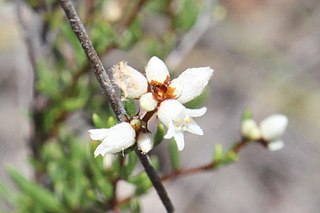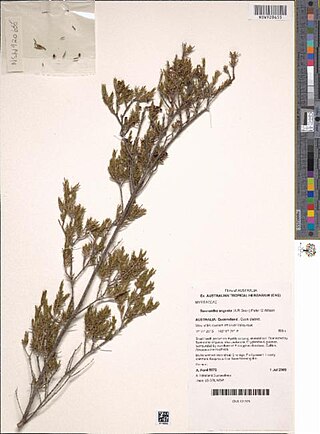
Micromyrtus blakelyi is a species of flowering plant in the family Myrtaceae and is endemic to a small area near Sydney Australia. It is a low, cushion-like shrub with overlapping, keeled, linear leaves and small pink flowers arranged singly in upper leaf axils.

Micromyrtus ciliata is a species of flowering plant in the family Myrtaceae and is endemic to south-eastern continental Australia. It is a spreading to erect shrub with crowded, oblong to egg-shaped leaves and small white or pink flowers arranged singly in upper leaf axils, forming clusters on the ends of branches.
Micromyrtus barbata is a species of flowering plant in the family Myrtaceae and is endemic to inland areas of Western Australia. It is a shrub with small, overlapping, narrowly egg-shaped leaves and small white flowers arranged singly in upper leaf axils.

Micromyrtus clavata is a species of flowering plant in the family Myrtaceae and is endemic to inland Western Australia. It is an erect, compact or sprawling shrub with erect, egg-shaped leaves with the narrower end towards the base and small white flowers arranged singly in upper leaf axils.
Micromyrtus fimbrisepala is a species of flowering plant in the family Myrtaceae and is endemic to inland Australia. It is a shrub with overlapping, broadly elliptic to more or less round leaves and small pink flowers arranged singly in upper leaf axils.

Micromyrtus flaviflora is a species of flowering plant in the myrtle family, Myrtaceae and is endemic to inland areas of Australia. It is an erect shrub with overlapping, keeled, oblong leaves, and yellow flowers arranged singly in leaf axils, but often appearing clustered.
Homoranthus tricolor, is a flowering plant in the family Myrtaceae and is endemic to a small area in south-east Queensland. It is an upright shrub with linear to lance-shaped leaves and green, red and black flowers arranged singly or in pairs in upper leaf axils.
Triplarina bancroftii is a species of flowering plant in the myrtle family, Myrtaceae and is endemic to a restricted area of Queensland. It is a shrub with egg-shaped or elliptic leaves, flowers with five sepals and five relatively small white petals and sixteen to eighteen stamens.
Triplarina calophylla is a species of flowering plant in the myrtle family, Myrtaceae and is endemic to a restricted area of north Queensland. It is a shrub with egg-shaped leaves with the narrower end towards the base, flowers with five sepals, five white petals and fourteen or fifteen stamens.
Triplarina nitchaga is a species of flowering plant in the myrtle family, Myrtaceae and is endemic to a restricted area of north Queensland. It is a shrub with lance-shaped leaves with the narrower end towards the base, flowers with five sepals, five white petals and seventeen or eighteen stamens.
Triplarina paludosa is a species of flowering plant in the myrtle family, Myrtaceae and is endemic to the Blackdown Tableland in Queensland. It is a shrub with lance-shaped to linear leaves, flowers with five sepals, five white petals and fifteen to eighteen stamens.

Thryptomene parviflora is a species of flowering plant in the family Myrtaceae and is endemic to Queensland. It is a slender, erect shrub with decussate, linear to egg-shaped leaves with the narrower end towards the base, and flowers with five petals and five stamens arranged singly in leaf axils.
Thryptomene remota is a species of flowering plant in the family Myrtaceae and is endemic to the northern part of the Northern Territory. It is an erect shrub with linear to lance-shaped leaves with the narrower end towards the base, and white or cream-coloured flowers with ten stamens.

Baeckea omissa is a species of flowering plant in the family Myrtaceae and is endemic to eastern Australia. It is a shrub with egg-shaped to lance-shaped leaves with the narrower end towards the base and white flowers mostly with ten to fifteen stamens.

Cryptandra debilis is a species of flowering plant in the family Rhamnaceae and is endemic to north Queensland. It is a small shrub with clustered, linear leaves and densely-hairy, white, tube-shaped flowers.

Sannantha angusta is a species of flowering plant in the family Myrtaceae, and is endemic to eastern Australia. It has scaly to fibrous bark, narrowly lance-shaped to linear leaves and white flowers, and usually grows in forest on rocky hillsides. It was previously known as Babingtonia angusta, and has been cultivated as Baeckea sp. 'Clarence River'.
Micromyrtus albicans is a species of flowering plant in the myrtle family, Myrtaceae and is endemic to a small area of south-eastern Queensland. It is a slender shrub with overlapping, egg-shaped leaves and small white flowers.
Micromyrtus capricornia is a species of flowering plant in the myrtle family, Myrtaceae and is endemic to a small area of central eastern Queensland. It is a shrub with slightly drooping branchlets, overlapping, narrowly egg-shaped leaves and small white flowers.
Micromyrtus carinata is a species of flowering plant in the myrtle family, Myrtaceae and is endemic to a small area of south-eastern Queensland. It is a slender shrub with drooping branchlets, overlapping, egg-shaped to lance-shaped leaves and small white flowers arranged singly in leaf axils.

Micromyrtus delicata is a species of flowering plant in the myrtle family, Myrtaceae and is endemic to a small area of northern coastal Queensland. It is a shrub with overlapping, linear to narrowly egg-shaped leaves with the narrower end towards the base and small white flowers arranged singly in leaf axils.








